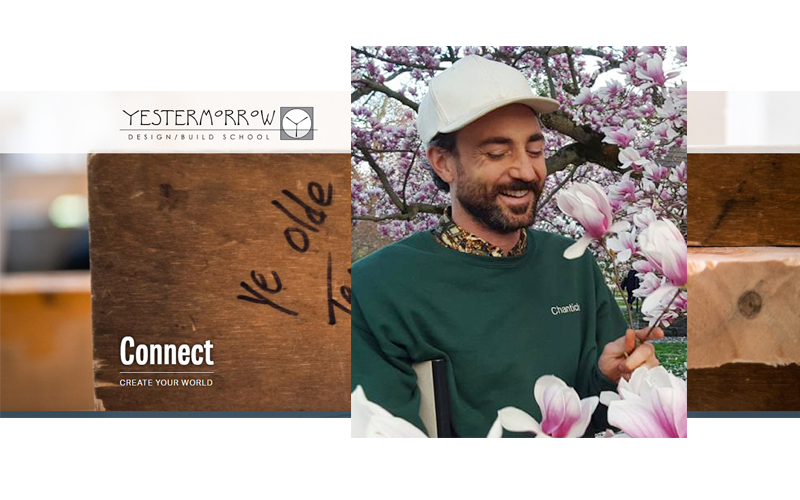What can people learn from microbes, when it comes to surviving in polluted environments? What do microbial communities have to do with design-build work? These were some of the questions posed by landscape designer Ian Quate in his talk on October 18 at Yestermorrow Design/Build School in Waitsfield.
Quate is the director at Marshall, North Carolina-based Fruit Studio, where he designs parks, plazas, trails, and other landscaped features across the Northeastern U.S. He also teaches landscape design at Yestermorrow.
In “Extremophile / Environmental(ism): A Study of the Gowanus Canal,” Quate talked about a research project that he began in 2014, collecting and analyzing microbes from toxic sludge at the bottom of the 1.8-mile-long Gowanus canal in South Brooklyn, New York City.
In 2010, the EPA named the canal a federal Superfund site – a classification given to some of the nation’s most contaminated land since 1980 when the program began. For 150 years, the canal functioned as a commercial shipping hub for coal-processing plants, tanneries, flour mills and other factories – all while these industries dumped their waste there. Even as factories closed down in the 1960s, the canal saw continued pollution, with raw sewage flowing into it during heavy rains.
Most of the toxic byproducts that industries dumped are embedded in several feet of sediment at the bottom of the canal, which Quate referred to as “black mayonnaise” – a sandy, noxious mixture composed of carcinogenic PCBs, petrochemicals, and heavy metals.
Elizabeth Hénaff, Quate’s collaborator and New York University researcher, wrote in the edited volume Atlas of Material Worlds (2021) that “the Gowanus sediment reeks of a damaged planet: petrochemical remnants of the industrial era and freshly decaying organic matter. The Gowanus is a special toxic cocktail of solvents and sewer overflow.”
Around 2014, Quate learned that the EPA was planning to dredge up much of this sediment, transport it to a special kind of landfill where toxic waste is amassed and cap the entire canal floor with concrete.
“I couldn’t help but wonder, as I became more familiar with this process,” Quate said in his talk, “what was living in the sediment, that had been around for more than 150 years of industrial use…and what information would we lose by carting these materials away?”
Quate is deeply interested in extremophiles – a class of microorganisms that can survive extreme environmental conditions, in terms of temperature, pressure, acidity and other factors. Having lived for most of earth’s history, they are not only equipped to exist in heavily polluted habitats, but they work to break down the toxic substances they are born into – including acids draining from mines and spent nuclear fuel.
There are currently 40,000 Superfund sites in the U.S., which Quate said “points to a legacy of industrial pollution that casts a pretty long shadow over our future generation’s land use.”
For his research, Quate, along with several researchers, got maps of the canal and selected 14 sampling sites. They dressed in Tyvek suits, gloves and goggles, got into a series of small boats and collected sediment with a sampling tool they devised from PVC pipe. They did this eight times, sending samples to the Brooklyn-based community biotech lab Genspace, whose technicians extracted DNA from the sludge. The team then sent this DNA over to a lab at Cornell University, where it was sequenced. Regarding everything that had to happen to the sediment sample and the DNA, Quate said that “it’s kind of like a design process at this nano-tech scale.”
Quate and his collaborators found that there were marine organisms in the sediment, as well as microbes typically found in the human gut, due to the high levels of sewage in the canal. They also found microbes that digest many of the pollutants found at the site.
“Organisms in the canal sediment were actively metabolizing – processing those same contaminants that the EPA was targeting for its cleanup,” Quate said, “but for the EPA, they were dumping it into a landfill, which doesn’t process the waste. It just isolates it.”
“I’m not suggesting we don’t clean up contaminated sites with the methods we have,” he added, “but it’s important to know that some microbes really thrive in these polluted conditions.” For microbes, he said, “these are their gardens of Eden.”
Quate got interested in superfund sites while doing a masters in landscape architecture at the Rhode Island School of Design. He focused his thesis project on a former open-pit copper mine in Montana, after learning that researchers studying the site found microbes that not only survived in the highly acidic pollution, but were creating compounds that had therapeutic potential in cancer medicine.
Even before graduate school, though, Quate often tagged along with his dad, a contractor, to landfills. “I’ve always been interested in where our waste goes, and how it relates to land use, and how we design spaces.”
Quate imagines possibilities for applying these findings about the Gowanus microbes to remediation efforts there, which are underway by the EPA. Instead of conventional concrete that will be poured into the canal to seal the bottom, he envisions a kind of bio-concrete – a more porous material that would allow oxygen to circulate, enabling organisms to metabolize waste even faster.
More broadly, Quate’s vision is to “take on a microbial perspective” when designing and constructing public spaces. “There are increasing amounts of evidence for ecologies existing in environments that traditionally, we would think of as being lifeless,” Quate said. Part of the exercise of sampling sediment from the canal, then, was to think about all these microbes in even the most toxic of environments. “It’s all alive,” he said, “it’s all pulsing with life, if we are able to see it.”
This talk was the second in a series about “sustainable sites,” held on Wednesday evenings from 6:30 to 8 p.m. The series runs through November 15.













